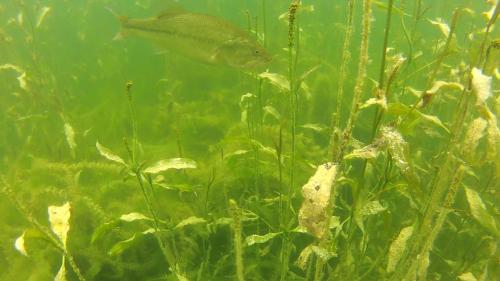Be careful what you wish for when managing aquatic weeds
Shallow lakes often suffer from excess nutrient inputs. Dense growth of aquatic plants can result, but plant management efforts can sometimes result in loss of water clarity and long-term problems with algae growth.
Merriam-Webster alternately defines “weed” as a plant that is not valued where it is growing or any aquatic plant. The first definition acknowledges that human values determine which plants are deemed weeds, while the second could be taken as proof that many people do not place much value on aquatic plants.
Aquatic ecologists tend to avoid the term “weeds” when referring to macrophytes – the rooted aquatic plants that many swimmers and boaters disdain. These plants provide food for waterfowl and habitat for fish, but they can also play a critical role in maintaining water clarity.
This is especially true in shallow lakes and ponds. In ecology, the alternative stable states concept acknowledges that ecosystems can sometimes have more than one stable equilibrium point. Many lakes and ponds have two stable states: weedy and clear or devoid of weeds and muddy. This leaves riparian landowners and lake managers with a choice between two undesirable endpoints when nutrient levels are intermediate.
Nutrients (primarily phosphorus) have an important role in determining the balance between rooted plants (“weeds”) and the suspended phytoplankton (algae) that contributes to turbidity (“muddiness”).
At low nutrient levels, the rooted plants win out because water is clear and plenty of light reaches the bottom of the lake. At high nutrient levels, the algae win out and effectively shade out rooted plants – this means extremely low water clarity and sometimes harmful algal blooms. At intermediate nutrient levels, things get a bit tricky. In this case, lakes can be pushed in one direction or the other – sometimes inadvertently.
In these intermediate lakes, additional nutrient inputs (perhaps from septic fields or urban and agricultural runoff) can push a lake past its threshold and result in “catastrophic transition” to a muddy and algae-dominated state. When this happens, it can be very difficult to restore water clarity and rooted plant communities.
Weed management might also push a lake over its threshold point. One study used computer simulations to investigate the outcome of various management strategies and found that management for intermediate vegetation density can be impossible in certain lakes. While intermediate levels of rooted vegetation are often ideal for fish, wildlife and human users, they can be impossible to attain in shallow lakes with intermediate nutrient levels.
While this might sound complex, reasons for the loss of water clarity following aquatic plant control are straightforward. Rooted plants prevent mucky bottoms from being stirred up by wind-driven currents, boating activity, and other disturbances. They also suppress algae growth by taking up nutrients. Some plants even release chemicals that further impede algae growth.
When rooted plants are destroyed, mucky bottoms get stirred up and re-suspend nutrients. Competition with algae ceases and foul blooms occur. If plant biomass is not mechanically removed, the rotting vegetation further adds to nutrient availability, turbidity, and algae growth.
If you are concerned about water clarity, be wary of large-scale vegetation control programs on shallow lakes. In other words, be careful what you wish for.



 Print
Print Email
Email


